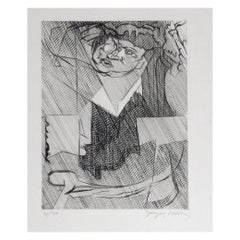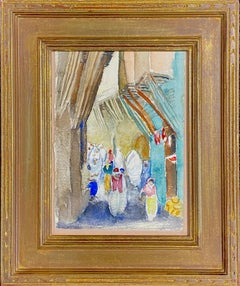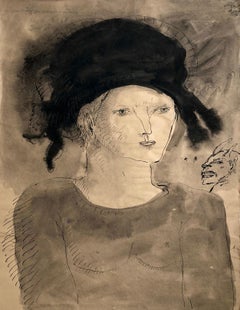Jacques Villon Paintings
French, 1875-1963
Jacques Villon was born Gaston Duchamp in 1875. He was the oldest brother of the artists Marcel Duchamp, Suzanne Duchamp-Crotti and the sculptor Raymond Duchamp-Villon. Initially a law student, in 1894 he went to Paris to study art. It was there that he met Henri Toulouse-Lautrec and other influential artists in Paris, and changed his name to Jacques Villon, after the poet. Villon made prints of some of the most well-known belle-époque portraits and genre scenes of the early twentieth century. Around 1911, he came under the influence of Picasso and other cubists, and became a leading exponent of the style, exhibiting in the 1913 Armory Show in New York. In 1922, the Galerie Bernheim-Jeune commissioned Villon to produce a series of color aquatints after 38 major nineteenth- and twentieth-century paintings. This series included works by Pierre Auguste Renoir, Henri Matisse, Pablo Picasso, Paul Cezanne, Georges Braque, Raoul Dufy, Amadeo Modigliani, Edouard Manet, Pierre Bonnard, and others. Artists who were alive at the time of the printing collaborated with Villon, and signed the prints. The project took ten years to complete. Several of these prints are valued highly today, and some went on to be reproduced by the Louvre Museum as photo-etchings. Villon's 'cubist' etchings, with their characteristic cross-hatching, are amongst the most renowned prints of the twentieth century. Jacques Villon's long career brought him fame. The diverse nature of his paintings, from end-of-the-century portraits to cubist and abstract styles to graphic works, made him a major figure in twentieth-century art. He was made a Grand Officer of the Légion d'Honneur, and upon his death in 1963, and he was given a state funeral.to
1
1
Overall Width
to
Overall Height
to
2
1
1
2
1
1
1
1
1
1
1
1
119
784
704
672
664
1
2
Artist: Jacques Villon
Vielle Femme en Petite Cape
By Jacques Villon
Located in Milwaukee, WI
Signed with stamp, J.V.
7-5/8" x 4-3/4" art
19" x 15-1/4" frame
Jacques Villon (French, 1875 - 1963) French painter, printmaker and illustrator. The oldest of three brothers who became major 20th-century artists, including Raymond Duchamp-Villon and Marcel Duchamp, he learnt engraving at the age of 16 from his maternal grandfather, Emile-Frédéric Nicolle (1830-94), a ship-broker who was also a much appreciated amateur artist. In January 1894, having completed his studies at the Lycée Corneille in Rouen, he was sent to study at the Faculty of Law of the University of Paris, but within a year he was devoting most of his time to art, already contributing lithographs to Parisian illustrated newspapers such as Assiette au beurre. At this time he chose his pseudonym: Jack (subsequently Jacques) in homage to Alphonse Daudet’s novel Jack (1876) and Villon in appreciation of the 15th-century French poet François Villon...
Category
Early 1900s Impressionist Jacques Villon Paintings
Materials
India Ink, Gouache
Jacques Villon Cubist Original Etching, 1951, “Figure de Femme”
By Jacques Villon
Located in Phoenix, AZ
Jacques Villon original etching “Figure de Femme” in the Cubist Surreal style.
Hand signed and numbered. Small Edition, created 1951.
Edition of 30 of which this print is no. 21. Unm...
Category
Mid-20th Century Jacques Villon Paintings
Materials
Paper
Related Items
Passageway North Africa, street scene
By Martha Walter
Located in Greenwich, CT
Passageway North Africa was executed during Walter’s extensive travels throughout Spain, Northern Africa, and the Dalmatian coast. These works are magnificent snapshots –pictorial po...
Category
1920s American Impressionist Jacques Villon Paintings
Materials
Watercolor, Archival Paper
Modern Figurative Surrealist Watercolor Painting, Drawing 'Prince of Innocence'
By Gary Hansmann
Located in Surfside, FL
Angelic boy with a devil figure.
Gary Hansmann (1947-2008) was active/lived in California. He is known for abstract, Surrealism figure painting.
Gary William Hansmann was born Dec. 4, 1940, in San Diego to Ethel May Williams and Lester Hughes Hansmann. He grew up in Encinitas and served in the Army in the early 1960s.
Gary Hansmann, San Diego artist, teacher and gallery owner, was known for his Surrealist drawings and graphics. He spent time working in Paris and exhibiting his art throughout Europe, but San Diego was home until he moved to Washington state. His life partner was fellow artist, Jill Hosmer. Mr. Hansmann, a respected printmaker and prolific artist, created thousands of drawings, prints and paintings as well as hundreds of poems. His interest in bullfighting led to a book of poetry and illustrations on the subject, “La Corrida, The Run”, a collection of poetry & artwork written as he was preparing for his first bullfight. Prologue written by famous Mexican Matador Antonio Lomelin. The book is written in English and translated into Spanish on opposing pages and was published in 1983. Mr. Hansmann taught intaglio and monotype at the Academy of Fine Arts in San Diego from 1977 to 1980 and at the San Diego Museum of Art in 1980. He also gave lectures and demonstrations throughout the art community, including at the San Diego Art Guild in Del Mar and Artist Equity in San Diego. Although he attended Palomar College in San Marcos and studied lithography at the San Diego Academy of Fine Arts, Mr. Hansmann was mostly self-taught and self-educated. Mr. Hansmann had shows in several art-world capitals, including Paris; Lisbon, Portugal; Cologne, Germany; Brussels, Belgium; and New York. he had one-person exhibits at the Loft Gallery in Clarkston, the Lewis-Clark State College Center of Arts & History, the Carnegie Art Center in Walla Walla and the Valley Art Center in Clarkston. During his long, distinguished career as an artist he had numerous one-person exhibits all over the world and the United States.
His group shows are too numerous to mention, but his one-person exhibits were in Koln, Germany; Bruxelles, Belgium; Paris, France; Viana do Castelo, Portugal; Lisbon, Portugal; Tecate, Mexico; and British Columbia, Canada; and many states at home.
Palomar College, San Marcos, Calif.
San Diego Academy of Fine Arts
Brooklyn Museum, Brooklyn, N.Y.
University of Southern California, Idyllwild (ISOMATA)
University of San Diego
San Diego Museum of Art
James Copley Library, La Jolla, Calif.
Biblioteca Nazionale Marciana, Venice, Italy
Centre de Arte Moderna
Gulbenkian Foundation, Lisbon, Portugal
Museo Taurino de la Communidad de Madrid, Madrid, Spain
Atelier Lacouriere et Frelaut, Paris, France
Gordon Gilkey Collection
Portland Art Museum, Portland, Or.
Coos Art Museum, Coos Bay...
Category
1980s Surrealist Jacques Villon Paintings
Materials
Paper, India Ink, Watercolor
1900's French Impressionist Watercolor Portrait Lady Overlooking Balcony Garden
Located in Cirencester, Gloucestershire
The Garden View
French School, early 20th century
signed with initials lower corner
watercolour painting on artist paper, framed
Glass covering
framed: 13 x 10.5 inches
board: 10 x 8...
Category
Early 20th Century Impressionist Jacques Villon Paintings
Materials
Watercolor
$750 Sale Price
30% Off
H 13 in W 10.5 in
Fine 17th Century Dutch Old Master Ink Drawing & Wash Visiting Angel
Located in Cirencester, Gloucestershire
The Angel
Dutch Old Master, 17th century
wash with pencil drawing on artist paper, framed
Glass covering
framed: 14 x 12.5 inches
board: 12.5 x 9.5 inches
condition: age related crea...
Category
17th Century Old Masters Jacques Villon Paintings
Materials
Gouache, Ink
$877 Sale Price
30% Off
H 14 in W 12.5 in
Belvedere Fountain (Blue Grey Cityscape with Impressionistic Figures)
By Susan Hope Fogel
Located in Hudson, NY
Belvedere Fountain (Blue Grey Cityscape with Impressionistic Figures)
After spending many years painting in the style of traditional realism, Susan had the opportunity to work with ...
Category
2010s American Impressionist Jacques Villon Paintings
Materials
Watercolor
Modern Figurative Surrealism Watercolor Painting, Drawing - Women On The Beach
By Gary Hansmann
Located in Surfside, FL
Gary Hansmann (1947-2008) was active/lived in California. He is known for abstract, Surrealism figure painting.
Gary William Hansmann was born Dec. 4, 1940, in San Diego to Ethel May...
Category
Late 20th Century Surrealist Jacques Villon Paintings
Materials
Paper, India Ink, Watercolor
$1,100
H 19.5 in W 26.5 in
Fall Courtship
By Vicente García de Paredes
Located in Wiscasset, ME
Born in Valencia, Spain in 1845, 19th century impressionist Vicente García de Paredes studied at the School of Fine Arts in Valencia, in Madr...
Category
1870s Impressionist Jacques Villon Paintings
Materials
Watercolor, Gouache
Sonia Spider Quenell, Watercolor portrait on archive paper.
By Manuel Santelices
Located in Miami Beach, FL
Movies, TV and magazines are constant source of inspiration. Fame, as fleckring and shallow it can be sometimes, is very intriguing to him.
The worlds of fashion, society and pop cu...
Category
21st Century and Contemporary Contemporary Jacques Villon Paintings
Materials
Ink, Paper, Watercolor, Gouache, Pen
$1,300
H 11 in W 14 in D 0.1 in
Child Play
By Lucio Pozzi
Located in New York, NY
Child Play is a watercolor painting on Fabriano paper by Italian-born multidisciplinary artist Lucio Pozzi. It is currently housed at Hal Bromm Gallery.
Category
1980s Jacques Villon Paintings
Materials
Paper, Watercolor
Sleep
By Lucio Pozzi
Located in New York, NY
Sleep is a watercolour painting by Italian-born multidisciplinary artist Lucio Pozzi. It is currently housed at Hal Bromm Gallery.
Category
1980s Jacques Villon Paintings
Materials
Paper, Watercolor
The Old Ways
By Lucio Pozzi
Located in New York, NY
The Old Ways is a watercolor and graphite painting on paper by Italian-born multidisciplinary artist Lucio Pozzi. It is currently housed at Hal Bromm Gallery.
Category
1980s Jacques Villon Paintings
Materials
Paper, Watercolor, Graphite
Art Deco Costume Design - Eva
By Georges Lepape
Located in Miami, FL
The paper in some of these photos looks overly textured due to the sharpness of the high-res digital camera.
In person, with the human eye, the paper looks reasonably smooth with out blemishes.
For this fashion illustration, Georges Lepape paints a stunning abstract pattern for the subject dress that is repeated in her hair. The work represents an early use of metallic paint, with silver metallic in the dress and bronze metallic in the blouse. Lepape's highly detailed drawing becomes more evident the closer you look. It's quite amazing how deftly he rendered facial feature on such a small scale. "Eva" 1918 Gouache, watercolor, and ink on paper Signed and dated, lower right: '1918' Inscribed, verso: "Costume for L'enfantement du mort, (miracle en pourpre, et or.). Devised by Marcel L'Herbier and performed at the Théatre Edouard VII and the Comédie des Champs-Elysées, 1919" Provenance: Ex-collection Lucien...
Category
1910s Art Deco Jacques Villon Paintings
Materials
Paper, Ink, Watercolor, Pencil, Gouache
Jacques Villon paintings for sale on 1stDibs.
Find a wide variety of authentic Jacques Villon paintings available for sale on 1stDibs. You can also browse by medium to find art by Jacques Villon in gouache, india ink, ink and more. Much of the original work by this artist or collective was created during the early 1900s and is mostly associated with the Impressionist style. Not every interior allows for large Jacques Villon paintings, so small editions measuring 15 inches across are available. Customers who are interested in this artist might also find the work of Marie Duhem, Eugene Galien-Laloue, and Victor Gabriel Gilbert. Jacques Villon paintings prices can differ depending upon medium, time period and other attributes. On 1stDibs, the price for these items starts at $16,800 and tops out at $16,800, while the average work can sell for $16,800.
Artists Similar to Jacques Villon
Recently Viewed
View AllMore Jacques Villon Art
Jacques Villon Prints and Multiples
Jacques Villon Drawings and Watercolor Paintings
Jacques Villon Figurative Prints
Jacques Villon Landscape Prints
Jacques Villon Abstract Prints
Jacques Villon Portrait Prints
Jacques Villon Figurative Drawings and Watercolors
Jacques Villon Animal Prints
Jacques Villon Interior Prints
Jacques Villon Nude Prints



